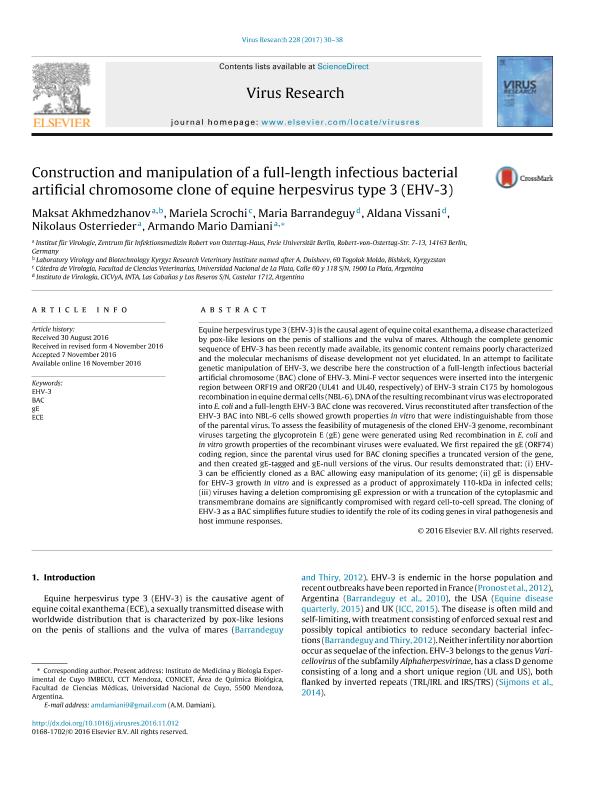Mostrar el registro sencillo del ítem
dc.contributor.author
Akhmedzhanov, Maksat
dc.contributor.author
Scrochi, Mariela Rita

dc.contributor.author
Barrandeguy, María Edith

dc.contributor.author
Vissani, Aldana

dc.contributor.author
Osterrieder, Nikolaus
dc.contributor.author
Damiani, Armando Mario

dc.date.available
2019-07-01T20:39:29Z
dc.date.issued
2017-01
dc.identifier.citation
Akhmedzhanov, Maksat; Scrochi, Mariela Rita; Barrandeguy, María Edith; Vissani, Aldana; Osterrieder, Nikolaus; et al.; Construction and manipulation of a full-length infectious bacterial artificial chromosome clone of equine herpesvirus type 3 (EHV-3); Elsevier Science; Virus Research; 228; 1-2017; 30-38
dc.identifier.issn
0168-1702
dc.identifier.uri
http://hdl.handle.net/11336/78981
dc.description.abstract
Equine herpesvirus type 3 (EHV-3) is the causal agent of equine coital exanthema, a disease characterized by pox-like lesions on the penis of stallions and the vulva of mares. Although the complete genomic sequence of EHV-3 has been recently made available, its genomic content remains poorly characterized and the molecular mechanisms of disease development not yet elucidated. In an attempt to facilitate genetic manipulation of EHV-3, we describe here the construction of a full-length infectious bacterial artificial chromosome (BAC) clone of EHV-3. Mini-F vector sequences were inserted into the intergenic region between ORF19 and ORF20 (UL41 and UL40, respectively) of EHV-3 strain C175 by homologous recombination in equine dermal cells (NBL-6). DNA of the resulting recombinant virus was electroporated into E. coli and a full-length EHV-3 BAC clone was recovered. Virus reconstituted after transfection of the EHV-3 BAC into NBL-6 cells showed growth properties in vitro that were indistinguishable from those of the parental virus. To assess the feasibility of mutagenesis of the cloned EHV-3 genome, recombinant viruses targeting the glycoprotein E (gE) gene were generated using Red recombination in E. coli and in vitro growth properties of the recombinant viruses were evaluated. We first repaired the gE (ORF74) coding region, since the parental virus used for BAC cloning specifies a truncated version of the gene, and then created gE-tagged and gE-null versions of the virus. Our results demonstrated that: (i) EHV-3 can be efficiently cloned as a BAC allowing easy manipulation of its genome; (ii) gE is dispensable for EHV-3 growth in vitro and is expressed as a product of approximately 110-kDa in infected cells; (iii) viruses having a deletion compromising gE expression or with a truncation of the cytoplasmic and transmembrane domains are significantly compromised with regard cell-to-cell spread. The cloning of EHV-3 as a BAC simplifies future studies to identify the role of its coding genes in viral pathogenesis and host immune responses.
dc.format
application/pdf
dc.language.iso
eng
dc.publisher
Elsevier Science

dc.rights
info:eu-repo/semantics/openAccess
dc.rights.uri
https://creativecommons.org/licenses/by-nc-sa/2.5/ar/
dc.subject
Bac
dc.subject
Ece
dc.subject
Equid Herpesvirus 3
dc.subject
Ge
dc.subject
Ehv-3
dc.subject.classification
Otras Ciencias Biológicas

dc.subject.classification
Ciencias Biológicas

dc.subject.classification
CIENCIAS NATURALES Y EXACTAS

dc.subject.classification
Otras Biotecnologías de la Salud

dc.subject.classification
Biotecnología de la Salud

dc.subject.classification
CIENCIAS MÉDICAS Y DE LA SALUD

dc.title
Construction and manipulation of a full-length infectious bacterial artificial chromosome clone of equine herpesvirus type 3 (EHV-3)
dc.type
info:eu-repo/semantics/article
dc.type
info:ar-repo/semantics/artículo
dc.type
info:eu-repo/semantics/publishedVersion
dc.date.updated
2019-05-23T19:12:45Z
dc.journal.volume
228
dc.journal.pagination
30-38
dc.journal.pais
Países Bajos

dc.journal.ciudad
Amsterdam
dc.description.fil
Fil: Akhmedzhanov, Maksat. Freie University Berlin; Alemania
dc.description.fil
Fil: Scrochi, Mariela Rita. Universidad Nacional de La Plata. Facultad de Ciencias Veterinarias. Departamento de Microbiología. Cátedra de Virología; Argentina
dc.description.fil
Fil: Barrandeguy, María Edith. Instituto Nacional de Tecnología Agropecuaria. Centro de Investigación en Ciencias Veterinarias y Agronómicas. Instituto de Virología; Argentina
dc.description.fil
Fil: Vissani, Aldana. Instituto Nacional de Tecnología Agropecuaria. Centro de Investigación en Ciencias Veterinarias y Agronómicas. Instituto de Virología; Argentina
dc.description.fil
Fil: Osterrieder, Nikolaus. Freie University Berlin; Alemania
dc.description.fil
Fil: Damiani, Armando Mario. Freie University Berlin; Alemania. Consejo Nacional de Investigaciones Científicas y Técnicas; Argentina
dc.journal.title
Virus Research

dc.relation.alternativeid
info:eu-repo/semantics/altIdentifier/url/https://www.sciencedirect.com/science/article/pii/S0168170216305536
dc.relation.alternativeid
info:eu-repo/semantics/altIdentifier/doi/https://doi.org/10.1016/j.virusres.2016.11.012
Archivos asociados
